2018 SUBARU WRX tires
[x] Cancel search: tiresPage 539 of 578

(562,1)
北米Model "A1700BE-B" EDITED: 2017/ 10/ 11
&Electrical systemAlternatorSTI 12V-110A
Except STI 12V-130A
Spark plugsTYPE RA ILFR7H (NGK)
STI except TYPE RA SILFR6A (NGK)
Except STIILKAR8H6 (NGK)&TiresTire sizeSTI—245/40R18 97W 245/35R19 89W
Except STI 235/45R17 94W 245/40R18 97W—
Wheel size
1768J 1868 1/2J 1968 1/2J
Pressure Front
33 psi (230 kPa, 2.3 kgf/cm
2)
Rear
32 psi (220 kPa, 2.2 kgf/cm2)
Wheel nut tightening torque
89 lbf·ft (120 N·m, 12 kgf·m)*1
*1: This torque is equivalent to applying approximately 88 to 110 lbf (40 to 50 kgf) at the end of the wheel nut wrench. If you have tightened the wheel nuts
by yourself, have the tightening torque checked at the nearest automotive service facility as soon as possible. For the wheel nut tightening procedure,
refer to“
Changing a flat tire”F9-5.Specifications/Specifications
12-8
Page 540 of 578
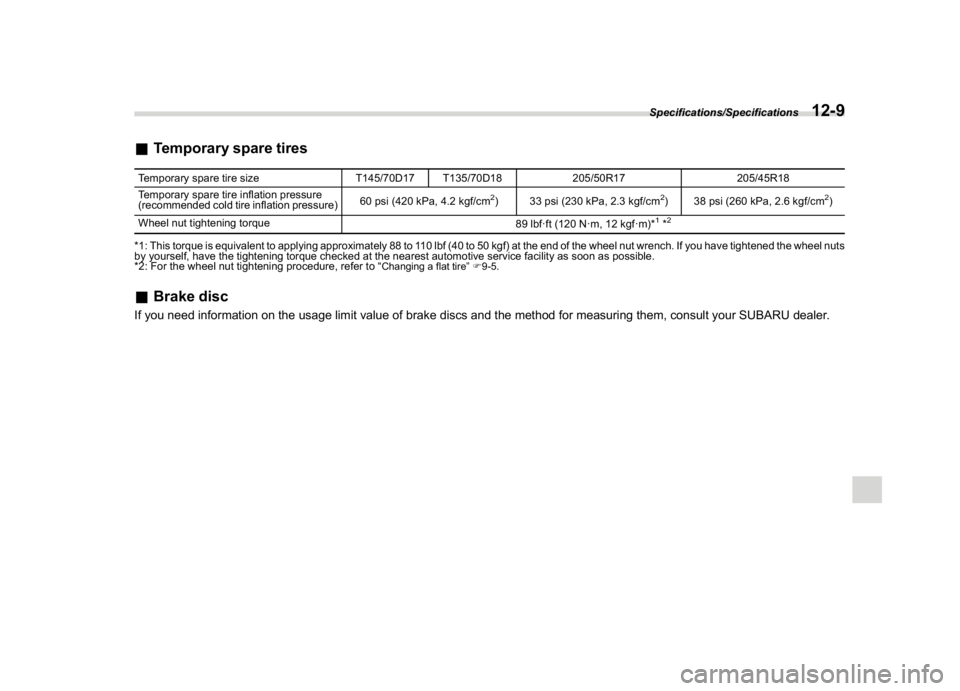
(563,1)
北米Model "A1700BE-B" EDITED: 2017/ 10/ 11
&Temporary spare tiresTemporary spare tire size T145/70D17 T135/70D18 205/50R17 205/45R18
Temporary spare tire inflation pressure
(recommended cold tire inflation pressure)60 psi (420 kPa, 4.2 kgf/cm
2) 33 psi (230 kPa, 2.3 kgf/cm
2) 38 psi (260 kPa, 2.6 kgf/cm
2)
Wheel nut tightening torque
89 lbf·ft (120 N·m, 12 kgf·m)*
1*2
*1: This torque is equivalent to applying approximately 88 to 110 lbf (40 to 50 kgf) at the end of the wheel nut wrench. If you have tightened the wheel nuts
by yourself, have the tightening torque checked at the nearest automotive service facility as soon as possible.
*2: For the wheel nut tightening procedure, refer to“
Changing a flat tire”F9-5.
&Brake discIf you need information on the usage limit value of brake discs and the method for measuring them, consult your SUBARU dealer.
Specifications/Specifications
12-9
12
Page 548 of 578
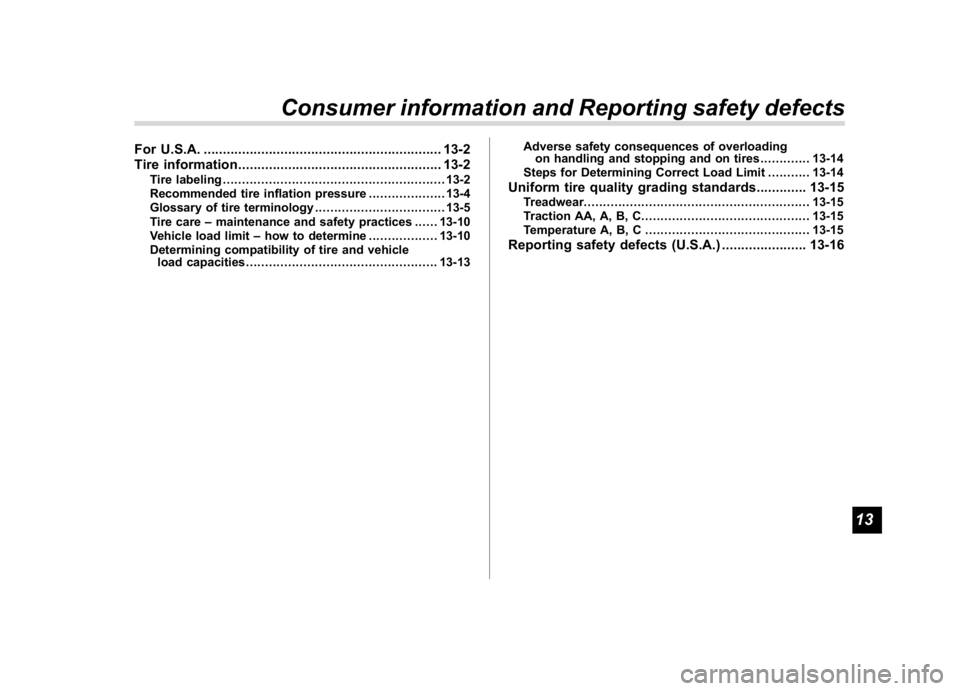
(573,1)
北米Model "A1700BE-B" EDITED: 2017/ 10/ 11
For U.S.A...............................................................13-2
Tire information.....................................................13-2
Tire labeling..........................................................13-2
Recommended tire inflation pressure....................13-4
Glossary of tire terminology..................................13-5
Tire care–maintenance and safety practices......13-10
Vehicle load limit–how to determine..................13-10
Determining compatibility of tire and vehicle
load capacities..................................................13-13Adverse safety consequences of overloading
on handling and stopping and on tires.............13-14
Steps for Determining Correct Load Limit ...........13-14
Uniform tire quality gradingstandards.............13-15
Treadwear...........................................................13-15
Traction AA, A, B, C............................................13-15
Temperature A, B, C...........................................13-15
Reporting safety defects(U.S.A.)......................13-16
Consumer information and Reporting safety defects
13
Page 550 of 578
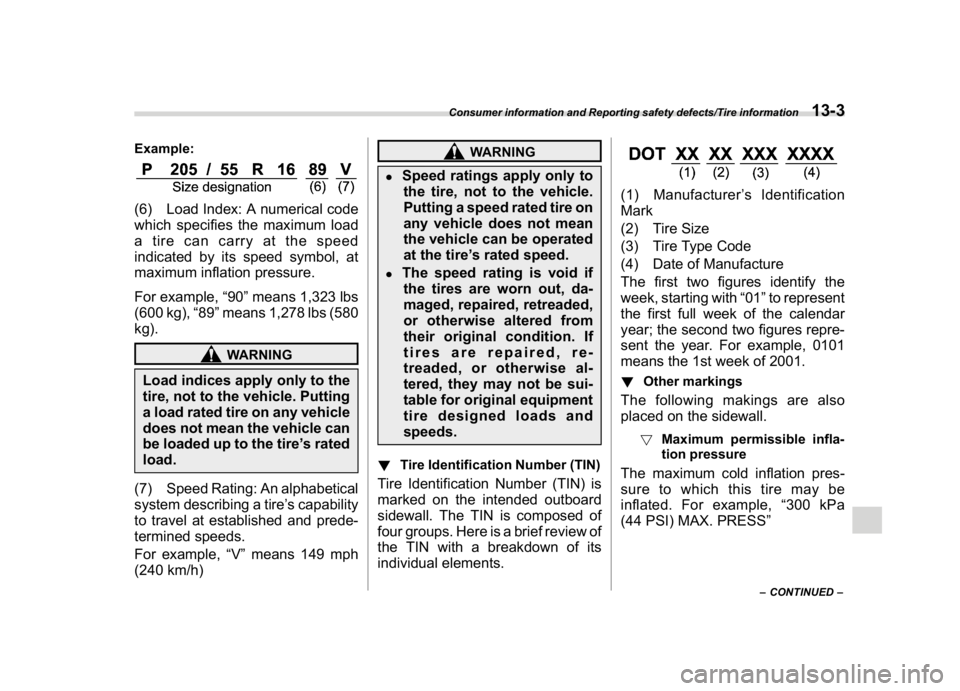
(575,1)
北米Model "A1700BE-B" EDITED: 2017/ 10/ 11
Example:(6) Load Index: A numerical code
which specifies the maximum load
a tire can carry at the speed
indicated by its speed symbol, at
maximum inflation pressure.
For example,“90”means 1,323 lbs
(600 kg),“89”means 1,278 lbs (580
kg).
WARNING
Load indices apply only to the
tire, not to the vehicle. Putting
a load rated tire on any vehicle
does not mean the vehicle can
be loaded up to the tire’s rated
load.
(7) Speed Rating: An alphabetical
system describing a tire’s capability
to travel at established and prede-
termined speeds.
For example,“V”means 149 mph
(240 km/h)
WARNING
.
Speed ratings apply only to
the tire, not to the vehicle.
Putting a speed rated tire on
any vehicle does not mean
the vehicle can be operated
at the tire’s rated speed.
.
The speed rating is void if
the tires are worn out, da-
maged, repaired, retreaded,
or otherwise altered from
their original condition. If
tires are repaired, re-
treaded, or otherwise al-
tered, they may not be sui-
table for original equipment
tire designed loads and
speeds.
!Tire Identification Number (TIN)Tire Identification Number (TIN) is
marked on the intended outboard
sidewall. The TIN is composed of
four groups. Here is a brief review of
the TIN with a breakdown of its
individual elements.
(1) Manufacturer’s Identification
Mark
(2) Tire Size
(3) Tire Type Code
(4) Date of Manufacture
The first two figures identify the
week, starting with“01”to represent
the first full week of the calendar
year; the second two figures repre-
sent the year. For example, 0101
means the 1st week of 2001.!Other markingsThe following makings are also
placed on the sidewall.
!Maximum permissible infla-
tion pressure
The maximum cold inflation pres-
sure to which this tire may be
inflated. For example,“300 kPa
(44 PSI) MAX. PRESS”
–CONTINUED–
Consumer information and Reporting safety defects/Tire information
13-3
13
Page 551 of 578

(576,1)
北米Model "A1700BE-B" EDITED: 2017/ 10/ 11
!Maximum load rating
The load rating at the maximum
permissible weight load for this tire.
For example,“MAX. LOAD 580 kg
(1279 LBS) @ 300 kPa (44 PSI)
MAX. PRESS.”
WARNING
Maximum load rating applies
only to the tire, not to the
vehicle. Putting a load rated
tire on any vehicle does not
mean the vehicle can be
loaded up to the tire’s rated
load.!Construction type
Applicable construction of this tire.
For example,“TUBELESS STEEL
BELTED RADIAL”
!Construction
The generic name of each cord
material used in the plies (both
sidewall and tread area) of this tire.
For example,“PLIES: TREAD 2STEEL + 2 POLYESTER SIDE-
WALL 2 POLYESTER”
!Uniform Tire Quality Grading
(UTQG)
For details, refer to“
Uniform tire
quality grading standards”F13-15.
&Recommended tire inflation
pressure!Recommended cold tire infla-
tion pressureFor recommended cold tire inflation
pressure for your vehicle’s tires,
refer to“
Tires”F12-8.
!Vehicle placard
The vehicle placard is affixed to the
driver’s side B-pillar.Example:The vehicle placard shows original
tire size, recommended cold tire
inflation pressure on each tire at
maximum loaded vehicle weight,
seating capacity and loading infor-
mation.!Adverse safety consequences
of under-inflationDriving at high speeds with exces-
sively low tire pressures can cause
the tires to flex severely and to
rapidly become hot. A sharp in-
Consumer information and Reporting safety defects/Tire information
13-4
Page 552 of 578

(577,1)
北米Model "A1700BE-B" EDITED: 2017/ 10/ 11
crease in temperature could cause
tread separation, and failure of the
tire(s). Possible resulting loss of
vehicle control could lead to an
accident.!Measuring and adjusting air
pressure to achieve proper in-
flationCheck and, if necessary, adjust the
pressure of each tire (including the
spare) at least once a month and
before any long journey. Check the
tire pressures when the tires are
cold. Use a pressure gauge to
adjust the tire pressures to the
specific values. Driving even a short
distance warms up the tires and
increases the tire pressures. Also,
the tire pressures are affected by
the outside temperature. It is best to
check tire pressure outdoors before
driving the vehicle. When a tire
becomes warm, the air inside it
expands, causing the tire pressure
to increase. Be careful not to mis-
takenly release air from a warm tire
to reduce its pressure.
&Glossary of tire terminology.
Accessory weight
The combined weight (in excess of
those standard items which may be
replaced) of automatic transmis-
sion, power steering, power brakes,
power windows, power seats, radio,
and heater, to the extent that these
items are available as factory-in-
stalled equipment (whether in-
stalled or not)..
Bead
The part of the tire that is made of
steel wires, wrapped or reinforced
by ply cords and that is shaped to fit
the rim..
Bead separation
A breakdown of the bond between
components in the bead..
Bias ply tire
A pneumatic tire in which the ply
cords that extend to the beads are
laid at alternate angles substantially
less than 90 degrees to the center-
line of the tread..
Carcass
The tire structure, except tread andsidewall rubber which, when in-
flated, bears the load.
.
Chunking
The breaking away of pieces of the
tread or sidewall..
Cold tire pressure
The pressure in a tire that has been
driven less than 1 mile or has been
standing for three hours or more..
Cord
The strands forming the plies in the
tire..
Cord separation
The parting of cords from adjacent
rubber compounds..
Cracking
Any parting within the tread, side-
wall, or inner liner of the tire
extending to cord material..
Curb weight
The weight of a motor vehicle with
standard equipment including the
maximum capacity of fuel, oil and
coolant, and if so equipped, air
conditioning and additional weight
optional engine.
–CONTINUED–
Consumer information and Reporting safety defects/Tire information
13-5
13
Page 557 of 578
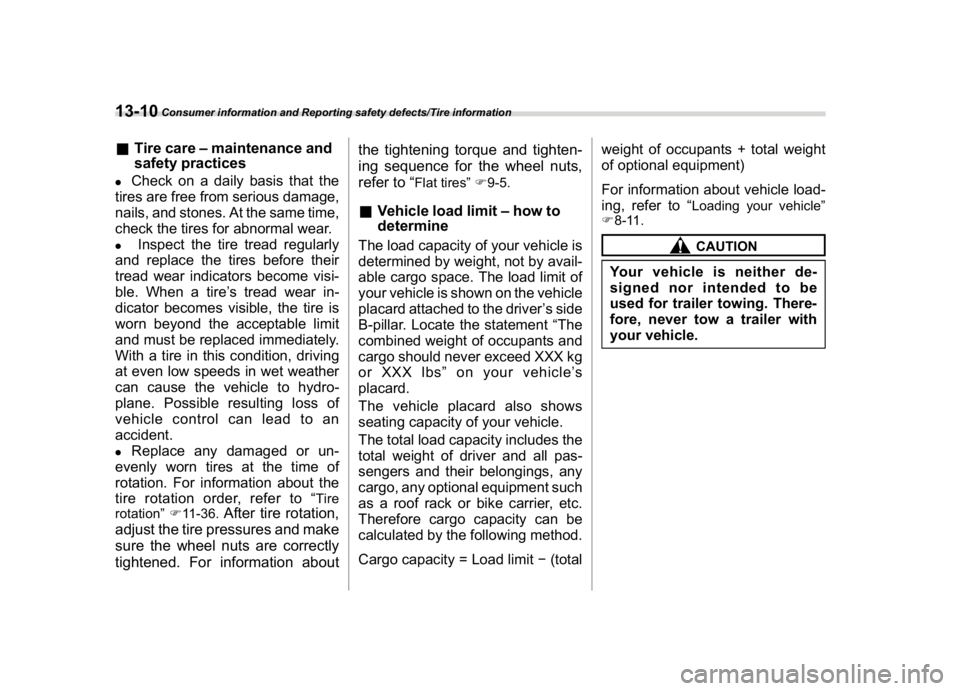
(582,1)
北米Model "A1700BE-B" EDITED: 2017/ 10/ 11
&Tire care–maintenance and
safety practices.
Check on a daily basis that the
tires are free from serious damage,
nails, and stones. At the same time,
check the tires for abnormal wear.
.
Inspect the tire tread regularly
and replace the tires before their
tread wear indicators become visi-
ble. When a tire’s tread wear in-
dicator becomes visible, the tire is
worn beyond the acceptable limit
and must be replaced immediately.
With a tire in this condition, driving
at even low speeds in wet weather
can cause the vehicle to hydro-
plane. Possible resulting loss of
vehicle control can lead to an
accident.
.
Replace any damaged or un-
evenly worn tires at the time of
rotation. For information about the
tire rotation order, refer to“
Tire
rotation”F11-36.
After tire rotation,
adjust the tire pressures and make
sure the wheel nuts are correctly
tightened. For information aboutthe tightening torque and tighten-
ing sequence for the wheel nuts,
refer to“
Flat tires”F9-5.
&Vehicle load limit–how to
determineThe load capacity of your vehicle is
determined by weight, not by avail-
able cargo space. The load limit of
your vehicle is shown on the vehicle
placard attached to the driver’s side
B-pillar. Locate the statement“The
combined weight of occupants and
cargo should never exceed XXX kg
or XXX lbs”on your vehicle’s
placard.
The vehicle placard also shows
seating capacity of your vehicle.
The total load capacity includes the
total weight of driver and all pas-
sengers and their belongings, any
cargo, any optional equipment such
as a roof rack or bike carrier, etc.
Therefore cargo capacity can be
calculated by the following method.
Cargo capacity = Load limit�(totalweight of occupants + total weight
of optional equipment)
For information about vehicle load-
ing, refer to“
Loading your vehicle”
F8-11.CAUTION
Your vehicle is neither de-
signed nor intended to be
used for trailer towing. There-
fore, never tow a trailer with
your vehicle.
Consumer information and Reporting safety defects/Tire information
13-10
Page 560 of 578
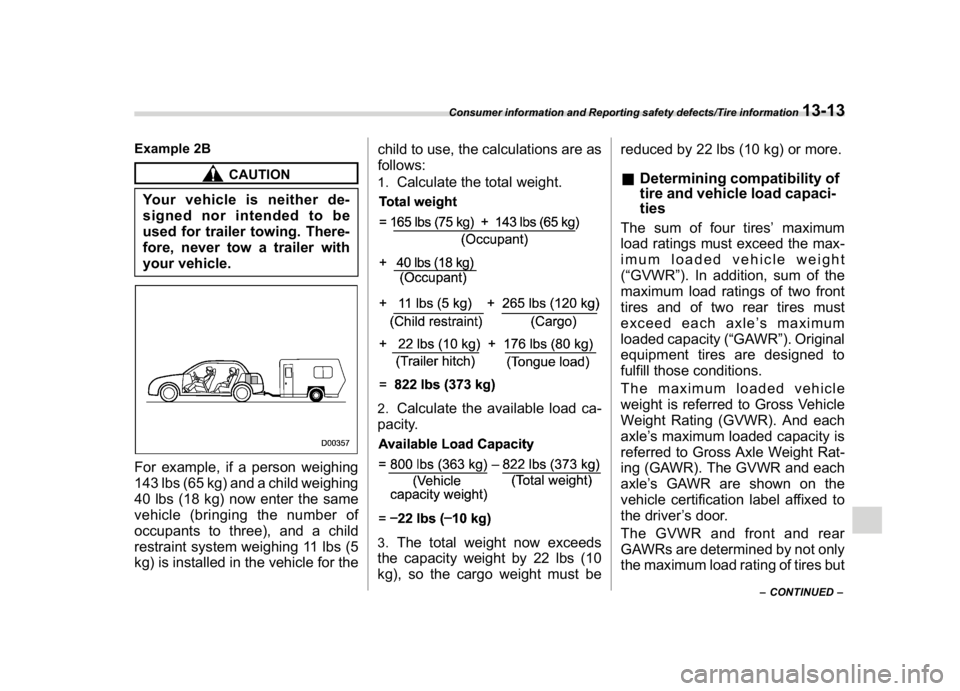
(585,1)
北米Model "A1700BE-B" EDITED: 2017/ 10/ 11
Example 2B
CAUTION
Your vehicle is neither de-
signed nor intended to be
used for trailer towing. There-
fore, never tow a trailer with
your vehicle.For example, if a person weighing
143 lbs (65 kg) and a child weighing
40 lbs (18 kg) now enter the same
vehicle (bringing the number of
occupants to three), and a child
restraint system weighing 11 lbs (5
kg) is installed in the vehicle for thechild to use, the calculations are as
follows:
1.
Calculate the total weight.
2.
Calculate the available load ca-
pacity.
3.
The total weight now exceeds
the capacity weight by 22 lbs (10
kg), so the cargo weight must bereduced by 22 lbs (10 kg) or more.
&Determining compatibility of
tire and vehicle load capaci-
tiesThe sum of four tires’maximum
load ratings must exceed the max-
imum loaded vehicle weight
(“GVWR”). In addition, sum of the
maximum load ratings of two front
tires and of two rear tires must
exceed each axle’s maximum
loaded capacity (“GAWR”). Original
equipment tires are designed to
fulfill those conditions.
The maximum loaded vehicle
weight is referred to Gross Vehicle
Weight Rating (GVWR). And each
axle’s maximum loaded capacity is
referred to Gross Axle Weight Rat-
ing (GAWR). The GVWR and each
axle’s GAWR are shown on the
vehicle certification label affixed to
the driver’s door.
The GVWR and front and rear
GAWRs are determined by not only
the maximum load rating of tires but
–CONTINUED–
Consumer information and Reporting safety defects/Tire information
13-13
13